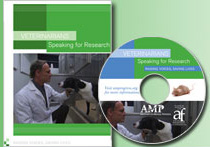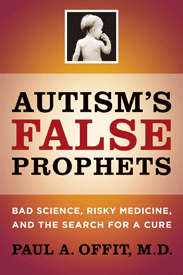
Americans for Medical Progress has produced a new DVD titled Veterinarians – Speaking for Research. (You can get your own free copy at the Americans for Medical Progress website.)
You might consider this DVD a follow-up of their previous DVD, Physicians – Speaking for Research (reviewed here). However, the two are pretty different, perhaps suggesting some differences not only in the intended audiences for the DVDs (veterinarians vs. physicians) but also in the concerns of the segments of the public each set of professionals is likely to encounter.
In this post, I’ll first discuss Veterinarians – Speaking for Research. Then, I’ll examine some interesting ways it differs from Physicians – Speaking for Research.
Category Archives: Scientist/layperson relations
Tracking the lag between promise and payoff.
One of the reasons non-scientists see science as at all valuable is that scientific research may result in useful medical treatments. And one of the aspects of science that seems elusive to non-scientists is just how long it can take scientific research to bring those useful medical treatments about.
In the 5 September 2008 issue of Science, Despina G. Contopoulos-Ioannidis, George A. Alexiou, Theodore C. Gouvias, and John P. A. Ioannidis [1] present research that examines just how long it has taken to get from initial discoveries to medical interventions.
Book review: Autism’s False Prophets.

Paul A. Offit, M.D., Autism’s False Prophets: Bad Science, Risky Medicine, and the Search for a Cure. Columbia University Press, 2008.
Autism’s False Prophets: Bad Science, Risky Medicine, and the Search for a Cure examines the ways that uncertainties about autism’s causes have played out in the spheres of medical treatment, liability lawsuits, political hearings, and media coverage. Offit’s introduction describes the lay of the land in 1916, as polio epidemics raged. That lay of the land, with public fear and willingness to pursue strange, expensive, and dangerous treatments, evokes a strong parallel to the current public mood about autism. It also evokes the hope that our current state is a “before” that (like polio’s “before”) will be followed by an “after” where sanity prevails about autism’s causes and treatments.
Against over-specialization.
In the 12 September, 2008 issue of Science, there is a brief article titled “Do We Need ‘Synthetic Bioethics’?” [1]. The authors, Hastings Center ethicists Erik Parens, Josephine Johnston, and Jacob Moses, answer: no.
Citizen scientists help track bee populations.
Stories about the honeybee crisis and colony collapse disorder (CCD) keep turning up in the news (at least here in California, where we grow so many big cash crops like almonds that rely on honeybees to pollinate them). But it turns out that getting to the bottom of CCD is made more difficult by the the gaps in biologists’ knowledge about the wild bee populations. (A lot of the bees pollinating food crops are commercially kept rather than wild.)
But, as reported in an article in the September-October 2008 issue of American Scientist [1], the Great Sunflower Project is enlisting the efforts of citizen scientists to fill in some of those gaps.
Retired congresscritter offers communication tips to scientists.
The congresscritter in question being Sherwood Boehlert, who represented New York’s 24th Congressional district (1983-2007), and chaired the House Science Committee (2001-2007). Boehlert offers this advice in a video called “Speaking for Science: Bringing Your Message to Policymakers,” available for download from the American Chemical Society website.*
The video presents two scenarios in which a group of scientists meets with their Congressional representative (who happens to be a member of the House Science Committee, played by Boehlert). As you might guess, the idea is to contrast the effective meeting with the disastrous one.
The Monty Hall problem and the nature of scientific discourse.
There’s a neat article [1] in the September-October 2008 issue of American Scientist (although sadly, this particular article seems not to be online) in which Brian Hayes discusses the Monty Hall problem and people’s strong resistance to the official solution to it.
Now, folks like Jason have discussed the actual puzzle about probabilities in great detail (on numerous occasions). It’s a cool problem, I believe the official solution, and I’m not personally inclined to raise skeptical doubts about it. What I really like about Hayes’s article is how he connects it to the larger ongoing discussion in which scientists engage:
The kind of thing that makes industry ‘science’ look bad.
In a post last week, I mentioned a set of standards put forward by Carol Henry (a consultant and former vice president for industry performance programs at the American Chemistry Council), who says they would improve the credibility of industry-funded research.
But why does industry-funded research have a credibility problem in the first place? Aren’t industry scientists (or academic scientists whose research is supported by money from industry) first and foremost scientists, committed to the project of building accurate and reliable knowledge about the world? As scientists, aren’t they just as hard-headed and devoted to objectivity — indeed, to truth — as the rest of their professional community?
I have no doubt that many industry (and industry-funded) scientists do take good knowledge-building as their most important job. And this means that some of those who depart from this commitment are making things harder for those scientists whose loyalties to their industry benefactors do not extend to misrepresenting the truth. Plus, of course, they may be misleading policy makers and the public by passing off as reliable scientific knowledge something that is not.
In the article “Tobacco Industry Influence on Science and Scientists in Germany,” [1] Thilo Grüning, Anna B. Gilmore, and Martin McKee draw on internal tobacco industry documents (released in 1998 as part of the settlement of litigation by the state of Minnesota against tobacco companies) to identify the strategies tobacco companies used to influence scientists and to distort science.
Science Debate 2008: It’s not the candidates’ answers that leave me cold
… but the questions that they were answering!
Regular readers will know (from these posts, among others) that I think the extent to which presidential candidates have gotten right with science (or with reliable advisers on same) is important information for voters to have.
Indeed, I was hoping to get some nourishing information (building an informed electorate and healthy democracy with 12 vitamins and minerals!) when I checked out Obama’s and McCain’s answers to the Science Debate 2008 questions. And, while it is possible to glean information about McCain’s and Obama’s attitudes toward science and its role in the public sphere from these answers, there was rather less straight talk than I had hoped.
The reason for that, I think, has a lot to do with the 14 questions actually put before the candidates — questions, Michael Eisen points out, that sidestep the science-y heart of the matter for all-too-familiar political territory:
Clinical trials — or not — of chelation therapy.
Back in July, Science ran an interesting news article about an on again, off again clinical trial of chelation therapy in the treatment of autistic children. I found the story fascinating because it highlights some of the challenges in setting up ethical research with human subjects — not to mention some of the challenges inherent in trying to help humans to make good decisions grounded in the best available scientific knowledge.
From the Science article:
